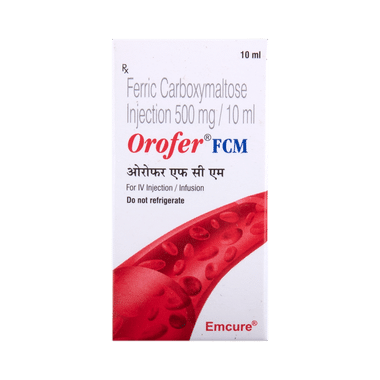All Details About Orofer FCM Injection
Find out detailed description, uses, directions of use, side effects, warnings and precautions, frequently asked questions about Orofer FCM Injection
Description:
Orofer FCM Injection is an iron replacement medicine. It is used to treat a type of anemia where you have fewer amount of red blood cells due to insufficient iron in your body (iron-deficiency anemia). Iron is needed to produce the red blood cells that carry oxygen around your body.Orofer FCM Injection is given by injection or infusion (saline drip) into a vein by your doctor or nurse. You will be watched carefully to make sure you do not have an allergic reaction. It is usually given in two doses, seven days apart. Your doctor will decide how much and how often you may need injections to improve your anemia. Eating a well-balanced diet that has enough iron, vitamins, and minerals can help to replenish your iron reserves. Outstanding sources of iron include meat, eggs, raisins, broccoli, and lentils.
The most common side effects include vomiting, headache, dizziness, high blood pressure, and pain or irritation at the site of injection. Most of these usually go away within a short time of the injection. If you are bothered by them or they go on for longer, talk to your doctor or nurse. You should not have this medicine if your anemia is not caused by a lack of iron.
Earlier taking it, tell your doctor if you have rheumatoid arthritis, asthma or other allergies, high blood pressure, or liver problems. This may affect your treatment. It is not known whether this medicine is safe for use if you are pregnant or breastfeeding so please take advice from your doctor. You will have tests to check your blood cells and iron levels, monitor your progress, and check for side effects. It may be advisable to limit alcohol during treatment.
Directions For Use:
Your doctor or nurse will give you this medicine. Compassionately do not self administer.Side Effects:
Most side effects do not require any medical attention and disappear as your body adjusts to the medicine. Consult your doctor if they persist or if you’re worried about themOrdinary side effects of Orofer FCM
- Vomiting
- Nausea
- Murky colored stool
- Headache
- Dizziness
- High blood pressure
- Injection site reactions (pain, swelling, redness)
Warning & Precautions:
Alcohol
CONSULT YOUR DOCTOR
It is not known whether it is safe to consume alcohol with Orofer FCM Injection. Please consult your doctor.
Pregnancy
CONSULT YOUR DOCTOR
Orofer FCM Injection may be unsafe to use during pregnancy. Although there are limited studies in humans, animal studies have shown harmful effects on the developing baby. Your doctor will weigh the benefits and any potential risks before prescribing it to you. Please consult your doctor.
Breast feeding
SAFE IF PRESCRIBED
Orofer FCM Injection is safe to use during breastfeeding. Human studies suggest that the drug does not pass into the breastmilk in a significant amount and is not harmful to the baby.
Driving
SAFE
Orofer FCM Injection does not usually affect your ability to drive.
Kidney
SAFE IF PRESCRIBED
Orofer FCM Injection is probably safe to use in patients with kidney disease. Limited data available suggests that dose adjustment of Orofer FCM Injection may not be needed in these patients. Please consult your doctor.
Liver
CAUTION
Orofer FCM Injection should be used with caution in patients with liver disease. Dose adjustment of Orofer FCM Injection may be needed. Please consult your doctor.
FAQs:
Q. What precautions are required while administering Orofer FCM Injection?
Orofer FCM Injection should be administered by staff that is trained in dealing with serious allergic reactions (anaphylactic reaction). Orofer FCM Injection can be administered as an undiluted injection, directly into the vein or via a dialyzer if the patient is on dialysis. It can also be diluted with sodium chloride and given as infusion directly into the vein. The patient should be monitored for at least 30 minutes after each injection. Also, the injection should not be given below the skin (subcutaneous route) or in the muscle (intramuscular route).
Q. How should Orofer FCM Injection vials be stored before use?
Orofer FCM Injection vials should be stored at 20°C to 25°C (68°F to 77°F). Remember, these should not be freezed. The temperature should not deviate more than 15°C to 30°C (59°F to 86°F).
Q. How often can Orofer FCM Injection be re-injected?
Usually, two doses of this medicine are given 7 days apart. The hemoglobin is then assessed at least 4 weeks after the final injection to allow time for the RBCs to form. If the reports still show deficiency of iron, it can be re-administered depending on individual need.
Q. Can Orofer FCM Injection cause an increase in blood pressure?
Affirmative, Orofer FCM Injection may cause a temporary increase in blood pressure accompanied with facial flushing, dizziness, and nausea. This may occur immediately after you take the medicine and generally disappears within 30 minutes.
Q. What should be done if leakage of Orofer FCM Injection occurs?
Incorrect administration of Orofer FCM Injection may cause leakage of the medicine at the administration site. The administration must be stopped immediately if there is some leakage. The leakage may cause skin irritation and long-lasting brown discoloration of skin at the administration site.
Q. Is Orofer FCM Injection safe in pregnancy?
There is limited data on the use of Orofer FCM Injection in pregnancy. It is important to tell your doctor if you are pregnant or are planning to have a baby. Consult your doctor if you become pregnant during treatment with Orofer FCM Injection. Your doctor will decide whether you need to continue treatment or discontinue it.
Disclaimer:
Getomeds primary intention is to ensure that its consumers get information that is reviewed by experts, accurate, and trustworthy. The information and contents of this website are for informational purposes only. They are not intended to be a substitute for professional medical advice, diagnosis, or treatment. Please seek the advice of your doctor and discuss all of your concerns about any disease or medication. Do not disregard or postpone seeking professional medical advice because of something you read on Getomeds. Our mission is to support, not replace, the doctor-patient relationship.

